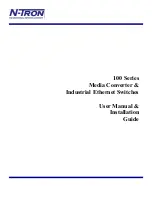
154
Valid values are in the range 1 to 200000000.
Priority
Controls the port priority. This can be used to control priority of ports having
identical port cost. (See above).
Default:
128
Range: 0-240, in steps of 16
AdminEdge
Controls whether the operEdge flag should start as beeing set or cleared. (The
initial operEdge state when a port is initialized).
AutoEdge
Controls whether the bridge should enable automatic edge detection on the
bridge port. This allows operEdge to be derived from whether BPDU's are
received on the port or not.
Restricted Role
If enabled, causes the port not to be selected as Root Port for the CIST or any
MSTI, even if it has the best spanning tree priority vector. Such a port will be
selected as an Alternate Port after the Root Port has been selected. If set, it can
cause lack of spanning tree connectivity. It can be set by a network administrator
to prevent bridges external to a core region of the network influence the spanning
tree active topology, possibly because those bridges are not under the full control
of the administrator. This feature is also known as
Root Guard
.
Restricted TCN
If enabled, causes the port not to propagate received topology change
notifications and topology changes to other ports. If set it can cause temporary
loss of connectivity after changes in a spanning tree's active topology as a result
of persistently incorrect learned station location information. It is set by a network
administrator to prevent bridges external to a core region of the network, causing
address flushing in that region, possibly because those bridges are not under the
full control of the administrator or the physical link state of the attached LANs
transits frequently.
BPDU Guard
If enabled, causes the port to disable itself upon receiving valid BPDU's. Contrary
to the similar bridge setting, the port
Edge
status does not effect this setting.
A port entering error-disabled state due to this setting is subject to the bridge Port
Error Recovery setting as well.
Point-to-point
Controls whether the port connects to a point-to-point LAN rather than a shared
medium. This can be automatically determined, or forced either true or false.
Transitions to the forwarding state is faster for point-to-point LANs than for
shared media.
Buttons
: Click to apply changes
Summary of Contents for NS4702-24P-4S-4X
Page 1: ...NS4702 24P 4S 4X User Manual P N 1072829 REV 00 01 ISS 14JUL14 ...
Page 23: ...23 Storage Temperature 10 70 degrees C Relative Humidity 5 95 non condensing ...
Page 164: ...164 Figure 4 8 2 Multicast Flooding ...
Page 183: ...183 Figure 4 8 14 IGMP Snooping VLAN Configuration Page Screenshot ...
Page 189: ...189 Figure 4 8 17 MLD Snooping Groups Information Page Screenshot ...
Page 208: ...208 Figure 4 9 6 QoS Egress Port Tag Remarking Page Screenshot ...
Page 218: ...218 Deletes the QCE The lowest plus sign adds a new entry at the bottom of the list of QCL ...
Page 229: ...229 Figure 4 9 18 Voice VLAN Configuration Page Screenshot ...
Page 299: ...299 Figure 4 11 17 Add User Properties Screen Figure 4 11 18 Add User Properties Screen ...
Page 336: ...336 Figure 4 14 2 LLDPMED Configuration Page Screenshot ...
Page 357: ...357 Figure 4 15 4 VeriPHY Cable Diagnostics Page Screenshot ...
Page 367: ...367 ...
Page 391: ...391 ...
















































